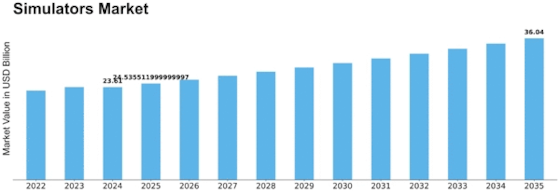Immersive Learning on the Rise: What’s Powering the Simulators Market Boom

Defence organisations worldwide are undergoing rapid restructuring to strengthen readiness, minimise operational risk, and adapt to increasingly multi-domain mission environments. As missions become more complex and equipment systems grow more advanced, training needs have quickly outgrown the limitations of traditional field exercises. Modern military forces are transitioning toward digital training ecosystems that provide realistic, repeatable, and cost-efficient learning environments. Driving this shift is the accelerated adoption of simulation technologies—systems capable of replicating real operational challenges with precision, without exposing personnel or equipment to the dangers of live training.
This widespread shift is strongly reflected in the evolution of the military simulation and virtual training industry, he defence simulation landscape is experiencing growing demand as military forces prioritise intelligent, scalable, and immersive training solutions. Virtual platforms now support land, air, naval, and joint-force exercises, allowing personnel to rehearse missions in synthetic environments tailored to operational requirements. These systems enable realistic scenario manipulation, adversary behaviour modelling, and seamless integration with live or constructive training elements. Together, these capabilities enhance mission preparation while significantly lowering the cost and logistical challenges associated with traditional field exercises.
Beyond financial efficiencies, simulation provides strategic advantages in preparing forces for diverse and rapidly evolving threat environments. Trainees can develop tactical decision-making, communication, coordination, and equipment-handling skills within environments that reflect real-world operational conditions. As defence agencies pursue heightened readiness and joint-force interoperability, simulation technology delivers unmatched flexibility—allowing multiple units across different geographies to train simultaneously and build shared operational awareness in ways that traditional training cannot achieve.
Another key strength of simulation is its ability to evolve in line with advancing defence technologies. With the increasing use of unmanned systems, electronic warfare capabilities, and advanced surveillance platforms, simulation provides a critical sandbox for experimentation, doctrine testing, and concept development. This adaptability ensures that forces remain prepared for operational environments that shift at a rapid pace.
As simulation solutions continue to advance through AI-generated scenarios, data-augmented performance feedback, and fully immersive VR training environments, the military simulation and virtual training sector is positioned for sustained long-term growth. Defence organisations that prioritise these technologies will enhance operational efficiency, improve preparedness, and reduce long-term training expenditures.
Table of Contents
SECTION I: EXECUTIVE SUMMARY AND KEY HIGHLIGHTS
SECTION II: SCOPING, METHODOLOGY AND MARKET STRUCTURE
SECTION III: QUALITATIVE ANALYSIS
SECTION IV: QUANTITATIVE ANALYSIS
SECTION V: COMPETITIVE ANALYSIS ........
FAQs
What is the projected market valuation of the Simulators Market by 2035?
The Simulators Market is projected to reach a valuation of 36.04 USD Billion by 2035.
What was the overall market valuation of the Simulators Market in 2024?
The overall market valuation of the Simulators Market was 23.61 USD Billion in 2024.
Which companies are considered key players in the Simulators Market?
Key players in the Simulators Market include Lockheed Martin, Northrop Grumman, Thales Group, CAE Inc., Boeing, Raytheon Technologies, L3Harris Technologies, etc.
Related Report:
- Live Stream
- Causes
- Crafts
- Dance
- Drinks
- Film
- Fitness
- Food
- Games
- Gardening
- Health
- Home
- Literature
- Music
- Networking
- Other
- Party
- Religion
- Shopping
- Sports
- Theater
- Wellness
- Art
- Life
- Coding




